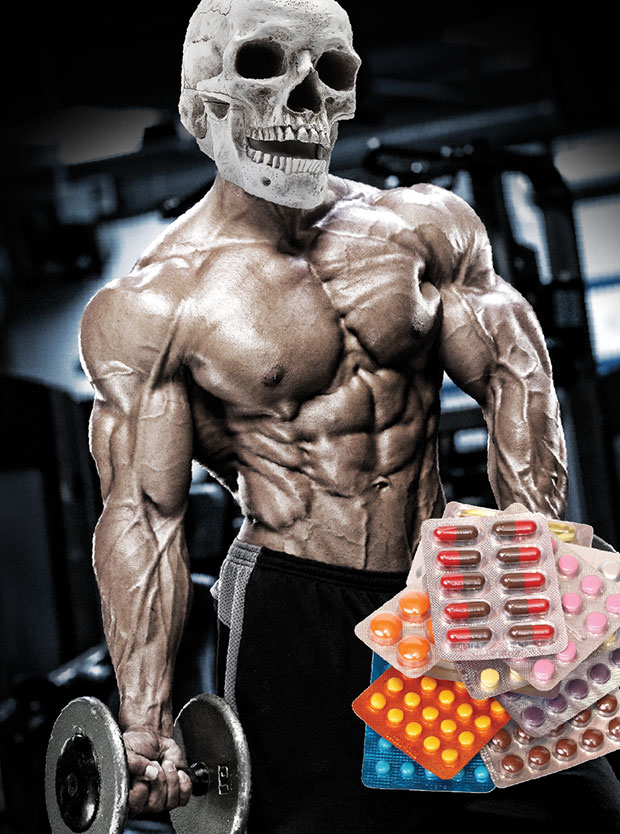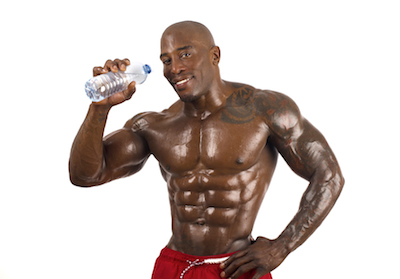Get Ripped or Die Trying

Playing the Game of Diuretics
I’ve never been much of a gambler.
In fact, I’ve never set foot in a casino, don’t know how to play poker and couldn’t care less about figuring how to place a bet. But with so many eagerly playing the odds with the hope of “winning it all,” why is it that I’ve stayed away from gambling altogether?
It could be a lifelong hate for determining probabilities, or the fact that I’ve never considered myself to be a “lucky” person.
Most likely, the reason why I don’t gamble or understand why people do it is quite simple: It’s random, it’s risky, and it always comes with an element of unpredictability.
I know what you’re thinking: Isn’t this an article about diuretics? Bring on the secrets!
Sorry if you were hoping for all the industry secrets to beat the bloat—I can’t even offer you a “skin thinning” jackpot. What I can do is provide you with some insight into the game of diuretics—from learning the kidneys’ physiology to understanding how different drugs play into water loss in order to put an end to gambling with your health.

Over the years, anabolic steroids have received a pretty ugly reputation; however, the reality is that a group of drugs called diuretics are one of the most dangerous in an athlete’s arsenal. Commonly known as “water pills,” diuretics are a classification of drugs that are used to eliminate fluid from the body through increasing the amount of water that passes through the kidneys. To understand how diuretics work, it’s important to first understand how the kidneys function, just as you should understand a game of chance before betting money!
Who Rules the Game?
Just as a card dealer controls your fate, the kidneys manage how diuretics and the “drying out” process works. They determine water loss or gain depending on what type of diuretic is being used, along with a wide variety of other functions inside your body. As one of our main waste management organs, the kidneys filter blood in order to prevent the buildup of by-products and extra fluids in the body. Every day, more than 1,600 litres of blood passes through the kidneys; that works out to about one litre of blood every minute!
If you’ve been on the receiving end of a kidney shot, you probably don’t need any explanation of where the kidneys are located. If you haven’t been so lucky, they’re found just below the rib cage on either side of the spine. The kidneys are a pear-shaped, solid organ with three main roles, which we will call “the 3 Cs.”
1. The kidneys clean: The kidneys’ main function is to filter waste products from the blood and pass it out of the body as urine. But producing urine isn’t as simple as drink, pee, repeat. In fact, many highly complex processes must take place to keep our bodies clean. Housed within each kidney are thousands of tiny filters called nephrons, which allow our kidneys to make pee. Essentially, the nephrons’ role is to eliminate water, electrolytes, and waste products from the body.

2. The kidneys control. The kidneys regulate the body’s water, salts, minerals, and acid content. During the cleaning process, the nephrons keep the “good stuff,” which includes particular compounds that the body needs to function. When filtering blood, the kidneys measure out what chemicals we need, such as sodium, potassium and phosphorus, and send these back into the body to be used. Our kidneys work hard to maintain the right balance of these substances to sustain life, but getting this right can sometimes prove to be difficult to do, especially when other variables such as excessive water, sodium, and diuretics are thrown into the mix.
3. The kidneys create. Last but not least, the kidneys are essential to creating hormones. Specifically, the kidneys produce three key hormones that control other body functions: erythropoietin (EPO), which stimulates the bones to make red blood cells; the active form of vitamin D, which maintains calcium for bones and provides normal chemical balance in the body; and renin, which regulates blood pressure. Keep in mind that in addition to making hormones, the kidneys also respond to a number of hormones, including vitamin D, aldosterone, prostaglandins, cortisol, parathyroid hormone, and calcitonin.
How to Beat the Game
Easy! Accept that you can’t.
In gambling, there’s a myth known as “betting systems,” where gamblers believe that for whatever reason they have found a guaranteed way to beat the game. This is complete nonsense; there really isn’t a surefire way to win most gambling games. Yet time and time again, people try and fail.
Attempting to manipulate your kidneys really is no different, thanks to the actions of a special hormone called anti-diuretic hormone (ADH). This hormone is also known as vasopressin, and it’s released by the pituitary gland. Medical terms aside, I often refer to ADH as “the forgotten one” because most people who try to manipulate water for aesthetic purposes have zero clue about what it is and what it does. I’ll give you a clue: The name of this hormone says it all.
Let’s see. “Anti” means “opposite.” “Diuretic” means “increasing urine production.” “Hormone” equals “chemical messenger.” What happens when a chemical messenger tells the body to do the opposite of increasing urine production? Water retention.
Hopefully you can see by now that the kidneys are pretty complicated and are host to a lot of important life-maintaining duties. As a result, keeping the kidneys in check is crucial to health. The body is able to do this in part through releasing ADH, whether you want it to or not. From the aftereffects of an inflammation-inducing workout that’s left you puffy, to looking bone-dry after a night of drinking, I’m sure most have seen the diuretic or anti-diuretic actions of ADH.

Guess what can cause enhanced ADH production? The inappropriate use of diuretics and the mismanagement of water, sodium, and other essential minerals. Yes meatheads, that’s right, you “spilled over” because of your own hormone production.
Diuretics and the Game of Chance
The class of pharmacological agents (aka “drugs”) that help eliminate fluid from the body is known as diuretics. Prescribed by practitioners to treat a wide variety of medical conditions such as high blood pressure, edema, heart failure, and certain kidney diseases, diuretics increase the amount of water that passes through the kidneys and promote the production of urine, leaving users “peeing like a racehorse.”
How do they do this? Well, simply put, diuretics cause a loss of water by partially paralyzing water reabsorption within each of our body’s little mini-cleaning army: the nephron. As a result, the rate of urination is elevated, with some powerful diuretics increasing the flow of urine from an average of one to two litres to a whopping six litres per day. All of this is made possible by diuretics’ dangerous and non-discriminating ability to purge essential minerals from the body (think back to the second job of the kidneys). Many diuretics’ main goal is to shed sodium, since it’s the compound that can hold the most water. However, during this process, other essential minerals also get “washed” away. Within the world of athletics, the result of this game of pharmaceutical Russian roulette has proven to be deadly.
Let’s talk about another gambling myth called “the gambler’s fallacy.” This is the idea that somehow a certain outcome is “due”—in fact, in the eyes of the gambler, a specific result seems so logical that nothing else is considered. He then goes ahead and make a huge bet, when in reality his odds of ever winning were close to none.
For example: If I take a diuretic, I will be peeled by pre-judging.

Surely, this seems like a probable outcome, correct? No. It’s the gambler’s fallacy. We already know about the role of ADH, so what else is there to consider? A lot, especially within the context of bodybuilding. In the last week before a competition, the body is already in an incredibly vulnerable state. Often it’s forgotten that factors such as stimulant use, an underactive thyroid gland, cascading sex hormone levels, stress levels, sleep, and carb intake all cause water retention that many times cannot be “fixed” by diuretic use. However, the fallacy still remains that taking a diuretic will result in the desired outcome of coming in looking “grainy,” “granite,” “like a road map,” or whatever other bro-tastic descriptions tickle your fancy.
The Deadly Half-Dozen
Although the main use of diuretics is to increase the amount of urine produced, they can make this happen in many different ways. As a result, these drugs are classified based on various criteria such as mechanism of action (how they work). I’ll cover all of the six main categories below but won’t oversaturate you with too many details. This is one conversation that can get a little dry!
We’ll start off with the ones that aren’t as common within the world of performance enhancement. The group of diuretics that are called carbonic anhydrase inhibitors are primarily used in clinical settings for treating glaucoma (eye pressure), and in the prevention of high-altitude mountain sickness (which can lead to serious edema), along with other health aliments such as sleep apnea. As far as performance enhancement goes, a CA won’t do much—that is, unless you’re looking to reduce inner eye pressure.

Up next, we have osmotic diuretics. This class of diuretics is relatively limited to a very small group of clinical settings such as reducing brain edema and mass before or after neurosurgery, cases of kidney death or injury, or in patients with acute high eye pressure. While you may not be familiar with this type of diuretic, if you’re a sugar-free food fan, you’ll recognize two of osmotic diuretics’ four ingredients: glycerin and mannitol (both sugar alcohols).
Now for the ones you may know…
Loop diuretics are commonly used in bodybuilding as they’re short-acting and highly potent, which means that the user will, generally speaking, see the effects quickly. However, this comes with a very large price! Loop diuretics work by forcing the kidneys to pass more fluid out by interrupting the normal transportation of salt and water within those tiny little nephrons (specifically in the “loop of Henle,” hence their name). While loop diuretics such as Lasix (furosemide) are used in the treatment of high blood pressure due to congestive heart failure or impaired kidney function, because of their strong and powerful effect on electrolyte balance, they ultimately shouldn’t be used in any off-label circumstance. From rapid water rebound to low-potassium-induced irregular heartbeats and even how they interact with other drugs, the results of loop diuretics mean they should be reserved for clinical applications only.
Let’s talk about thiazide and thiazide-like diuretics. This group of diuretics is the most widely used diuretic, and they’re often the first drug used to treat high blood pressure as they’re cheap and easy to use. Thiazides work by blocking the activity of sodium and chloride within the kidney’s nephrons—the distal convoluted tubule (DCT). By doing so, they cause more sodium and water loss. Similar to loop diuretics, thiazides can cause some pretty severe effects on the body’s ability to balance electrolytes. Athletes must also consider not only how thiazides work with other drugs, but also their effect on insulin. Interestingly, hydrochlorothiazide (a specific type of thiazide) is the most abused diuretic in sport.
And then there were two! Mineralocorticoid receptor (MR) antagonists (aka aldosterone antagonists) are often called “potassium-sparing diuretics” for their ability to save potassium. Aldosterone is a sex hormone that helps the body to regulate salt and water balance. This group of diuretics blocks aldosterone from being able to do this, and as a result, causes more urine to be produced. One of the most common MR antagonists is spironolactone, which is often used to treat high blood pressure and aldosterone, edema, and is even used as an anti-androgen. (If you’re wondering how a diuretic can be used to manipulate sex hormones, check out “Drug Zone” for the answer!)
Last but not least, we’ve got sodium channel blockers. They have several other names such as “inhibitors of renal epithelial sodium channels,” but I promised I would keep this conversation simple. For this class of diuretics, there are only two drugs that are used in clinical application: amiloride and triamterene, which, similar to aldosterone antagonists, are known for their ability to save potassium. On their own, sodium channel blockers are only mild diuretics; however, they’re often compounded with other diuretics to provide a stronger result. Why? It’s pretty basic.

Because of their disastrous effect on the body’s electrolyte balance, loop diuretics and thiazides ultimately cannot be used in high dosages. But what medical practitioners discovered is that they can be paired with mild potassium sparring diuretics to achieve the desired result.
Does that mean that a combo of diuretics is better for use? Hell, no! Get your head straight.
The High Rollers of Sport
For as long as there has been sport, there has been performance enhancement use. And while many of the undergraduates that I teach like to debate “the evidence” that diuretics can cause athletic performance gains, at the end of the day, they are in fact a compound that is commonly used in sport to gain some type of athletic advantage. Whether it’s as a masking agent to help cover up other banned substances, or to cause rapid water loss to help athletes meet a set weight class, diuretics have a pretty long rap sheet in the world of sport.
As noted in the introduction, pop culture has deceived us that anabolic steroids are demonic killers plaguing athletics, but after getting intimate with the research on diuretics, I’m left scratching my head as to why this group of drugs hasn’t gained a similar disdainful reputation.
In bodybuilding, we know that there are hushes and murmurs about the dangers of diuretics. In fact, I’ll throw the assumption out there that most fans of the sport have probably seen at least one competitor cramp up onstage, or like Cinderella turning from a princess into a maid, have experienced turning from a prune-like human on the day of a show into something that resembles the Stay Puft Marshmallow Man the morning after. So let me ask you this: Do you think this is healthy? What do you think is actually going on inside the body when there is rapid water loss caused by diuretics?
I know there will be naysayers who chirp comments such as “But I use diuretics safely!” Sorry, bro. Any time you force the body to eliminate excess water quickly, you’re taking a huge gamble. From severe health consequences such as heart failure, excessive electrolyte loss, and bowel obstruction (didn’t you ever wonder why so many competitors have poo-bloat onstage?), to having the whole “master plan” backfire when other unintended hormones are released, causing more water gained than lost, it’s safe to say that diving into the sea of diuretics is no different than doing a running cannonball into three feet of sewage. It doesn’t make sense, you’ll probably end up hurting yourself, and, well, it’s just stupid.
The next time you’re thinking about playing with diuretics, please think carefully and clearly about it. They’re illegal, illicit, and dangerous drugs, and not something that should be passed around backstage at a bodybuilding show without any clue of potential consequences. My goal in writing this piece wasn’t to crusade against the evils of drug use in sport. Let’s face it. No number of absurd metaphors or bro-friendly examples used to explain kidney anatomy will end diuretic use in sport. Ultimately, my hope is that diuretics will be thought less of as some magical pill that can “dry out fat” and more as the crackpot that they are.
Yes, it’s a gamble, and one with truly high stakes.
Are you willing to take a chance on the deadly half-dozen even when the odds are against you? Sure you may succeed, but you also may spill over, cramp up, or worse, find yourself hooked to IVs in the emergency room instead of collecting an overall trophy.
The game of diuretics shouldn’t be one of “get dry or die trying.” Don’t bet against your body and gamble with the ultimate prize—your health.
To learn more about diuretics, and steroids in general, check out more of Victoria's articles here!

